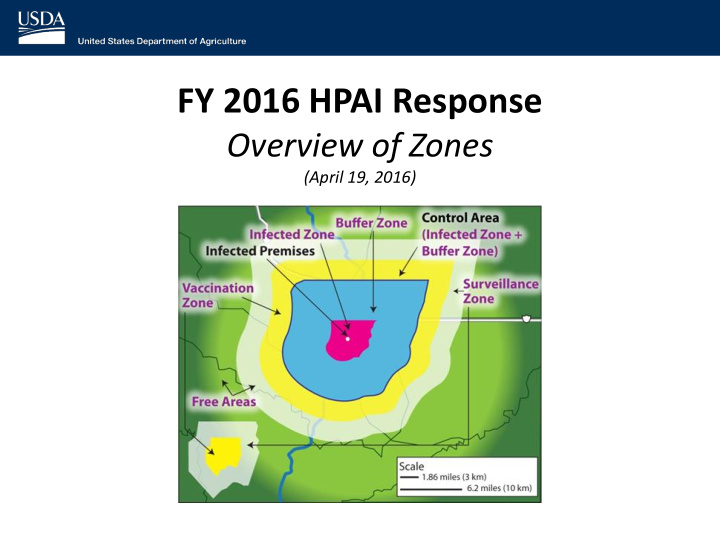



FY 2016 HPAI Response Overview of Zones (April 19, 2016) 1
Illustration of Zone and Area Designations In the Surveillance Zone (which is part of the Free In the Buffer Zone Area ), targeted poultry (which is part of the surveillance may be Control Area ), there conducted (i.e., commercial are movement premises). controls and surveillance activities. In the Free Area (which includes the In the Infected Zone Surveillance Zone ), (which is part of the routine or program Control Area ), there are surveillance may movement controls and occur (i.e., NPIP and surveillance activities. wild birds. Infected Premises are quarantined. Note: Since emergency vaccination was not implemented in the outbreak, Vaccination Zones and Vaccinated Premises are not further discussed. 2
Definitions of Zone and Area Designations Zone/Area Definition Infected Zone (IZ) Zone that immediately surrounds an Infected Premises. Zone the immediately surrounds an Infected Zone or a Contact Buffer Zone (BZ) Premises. Control Area (CA) Consists of an Infected Zone and a Buffer Zone. Zone outside and along the border of a Control Area. The Surveillance Zone (SZ) Surveillance Zone is part of the Free Area. Area not included in any Control Area. Includes the Surveillance Free Area (FA) Zone. 3
Definitions of Premises Designations Premises Definition Zone Premises where a presumptive positive case or confirmed positive case exists Infected Premises based on laboratory results, compatible clinical signs, HPAI case definition, and IZ (IP) international standards. Premises with susceptible animals that may have been exposed to HPAI, either Contact Premises directly or indirectly, including but not limited to exposure to animals, animal IZ, BZ (CP) products, fomites, or people from Infected Premises. Premises under investigation due to the presence of susceptible animals reported Suspect Premises to have clinical signs compatible with HPAI. This is intended to be a short-term IZ, BZ, SZ (SP) premises designation. Premises that have susceptible animals, but none of those susceptible animals have clinical signs compatible with HPAI. Premises objectively demonstrates that At-Risk Premises it is not an Infected Premises, Contact Premises, or Suspect Premises. At-Risk IZ, BZ (ARP) Premises may seek to move susceptible animals or products within the Control Area by permit. Only At-Risk Premises are eligible to become Monitored Premises. Premises objectively demonstrates that it is not an Infected Premises, Contact Premises, or Suspect Premises. Only At-Risk Premises are eligible to become Monitored IZ, BZ Monitored Premises. Monitored Premises meet a set of defined criteria in seeking Premises (MP) to move susceptible animals or products out of the Control Area by permit. Premises outside of a Control Area and not a Contact or Suspect Premises. Free Premises 4 SZ, FA (FP)
Example Zones, Areas and Premises Premises Zones and Areas Note: In an HPAI outbreak, the Incident Commander will work with the Operations Section and 5 Planning Section to determine the appropriate designations.
Factors Used to Determine Control Area Size Factors Additional Details • Effectiveness and efficiency of administration Jurisdictional areas • Multi-jurisdictional considerations: local, State, Tribal, and multistate • Areas defined by geography Physical • Areas defined by distance between premises boundaries • Survivability in the environment • Reproductive rate HPAI • Ease of diagnosis (for example, no • Incubation period Epidemiology • Ease of transmission pathognomonic signs; requires diagnostic laboratory testing) • Infectious dose • Age of lesions • Species susceptibility • Modes of transmission (such as, fecal-oral, droplet, aerosol, vectors) • Number of contacts o Age of animals Infected Premises characteristics • Transmission pathways and o Movement of traffic and personnel transmission risk to and from premises (fomite spread) o Extent of animal movement o Biosecurity measures in place at o Number of animals time of outbreak o Species of animals 6
Factors Used to Determine Control Area Size (cont.) Factors Additional Details • Movement of traffic (fomites) and • Number and types of premises Contact Premises personnel to and from premises characteristics • Susceptible animal populations (fomite spread) and population density • Biosecurity measure in place prior to • Animal movements outbreak • Wildlife as biological or mechanical • Types of premises in area or region Environment • Land use in area or region vectors • Susceptible wildlife and population density • Prevailing winds Climate (for • Humidity aerosol spread diseases) • Biosecurity practices in place prior to outbreak General area, • Biosecurity practices implemented once outbreak detected region, or agricultural sector bio-security 7
Factors Used to Determine Control Area Size (cont.) Factors Additional Details • Types of premises, animal movements, and network of animal and fomite Number of backyard or movements transitional premises • Continuity of business plans and processes in place or activated at beginning of Continuity of business outbreak (such as surveillance, negative diagnostic tests, premises biosecurity, and risk-assessments) • Permit processes, memorandums of understanding, and information management systems in place or activated at beginning of outbreak 8
Minimum Sizes of Zones and Areas Zone or Area Minimum Size and Details Infected Zone (IZ) Perimeter should be at least 3 km (~1.86 miles) beyond perimeters of presumptive or confirmed Infected Premises. Will depend on disease agent and epidemiological circumstances. This zone may be redefined as the outbreak continues. Buffer Zone (BZ) Perimeter should be at least 7 km (~4.35 miles) beyond the perimeter of the Infected Zone. Width is generally not less than the minimum radius of the associated Infected Zone, but may be much larger. This zone may be redefined as the outbreak continues. Control Area (CA) Perimeter should be at least 10 km (~6.21 miles) beyond the perimeter of the closest Infected Premises. Please see the table to the left for factors that influence the size of the Control Area. This area may be redefined as the outbreak continues. Surveillance Zone (SZ) Width should be at least 10 km (~6.21 miles), but may be much larger. 9
For More Information FAD PReP Website For more details on zones and premises designations, please see APHIS FAD Framework: Response Strategies (Manual 2-0) HPAI Response Plan: The Red Book 10
Recommend
More recommend